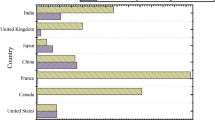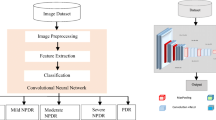Abstract
This paper presents early-automated glaucoma detection algorithm by extracting early diagnostic parameters, namely, parapapillary atrophy and Cup to Disc ratio using DIP. Glaucoma is optic neuropathy chronic eye diseases, which is progressed as intraocular pressure inside eyeball increases. Proposed method mainly consists of five stages, namely ROI extraction, pre-processing, diagnostic parameter extraction, feature extraction, and classification. First, optic disc region is extracted from fundus image because diagnostic parameters lie around OD. ROI is extracted using the horizontal and vertical edge of vascular tree in OD region. Diagnostic parameters such as CDR and PPA are extracted from ROI region. CDR is calculated using K-means clustering and polar transform. PPA is earliest sign of glaucoma. In many cases, occurrence of PPA before the increased CDR value gives indication of early glaucoma. PPA detection and extraction are accomplished using polar transform method and direct least-square fitting algorithm of an ellipse. Optimal categorization of PPA area and residue area is done by K-means clustering. Features of diagnostic parameters such as CDR and area of PPA are extracted for classification model. Features of fundus images are taken as input and labels as output for training parameters of SVM. SVM model is trained with five-fold validation on 141 images, which consists of healthy and glaucoma due to PPA and CDR. Thirty-nine images are used for testing of SVM model and sensitivity, specificity, and accuracy values are 100%, 88.2%, and 97.3% respectively. Diagnostic results obtained by proposed algorithm, about early glaucoma presence is further validated by ophthalmologist.
















Similar content being viewed by others
References
Abbas Q (2017) Glaucoma-Deep: Detection of Glaucoma Eye Disease on Retinal Fundus Images using Deep Learning,” Int J Adv Comput Sci Appl 8 (6)
Bishop CM (2006) Pattern Recognition and machine Learning. Springer Science Business Media, LLC
Budde WM, Jonas JB (2003) Influence of cilioretinal arteries on neuroretinal rim and parapapillary atrophy in glaucoma. Investig Ophthalmol Vis Sci 44(1):170–174
Chakravarty A, Sivaswamy J (2016) Glaucoma Classification with a Fusion of Segmentation and Image-based Features Arunava Chakravarty and Jayanthi Sivaswamy Center for Visual Information Technology , IIIT Hyderabad, India, no. i, pp. 689–692
Christopher M, Nakahara K, Bowd C, Proudfoot JA, Belghith A, Goldbaum MH, Rezapour J, Weinreb RN, Fazio MA, Girkin CA, Liebmann JM, De Moraes G, Murata H, Tokumo K, Shibata N, Fujino Y, Matsuura M, Kiuchi Y, Tanito M, Asaoka R, Zangwill LM (2020) Effects of study population, labeling and training on glaucoma detection using deep learning algorithms. Transl Vis Sci Technol 9(2):1–14
Claro, Maila, Rodrigo Veras, Andre Santana, Flavio Araujo, Romuere Silva, Joao Almeida, and Daniel Leite (2019) An hybrid feature space from texture information and transfer learning for glaucoma classification. Journal of Visual Communication and Image Representation 64:102597
Das JPM, Pranjal S, Nirmala R (2016) Diagnosis of glaucoma using CDR and NRR area in retina images. Netw Model Anal Heal Informatics Bioinforma 5(1):1–14
Fitzgibbon A, Pilu M, Fisher RB (1999) Direct Least Square fitting of ellipses,” ” IEEE Trans pattern Anal Mach Intell 21(5), 476–480, vol 21, no 5, pp 0–4
Fu H, Cheng J, Xu Y, Wong DWK, Liu J, Cao X (2018) Joint optic disc and cup segmentation based on multi-label deep network and polar transformation. IEEE Trans Med Imaging 37(7):1597–1605
Gonzale RC, Woods RE (1974) Digital Image Processing, vol 7, no 5
Gour N, Khanna P (2019) Automated glaucoma detection using GIST and pyramid histogram of oriented gradients (PHOG) descriptors. Pattern Recogn Lett 137:3–11
Issac A, Partha Sarathi M, Dutta MK (2015) An adaptive threshold based image processing technique for improved glaucoma detection and classification. Comput Methods Prog Biomed 122(2):229–244
Kausu TR, Gopi VP, Wahid KA, Doma W, Niwas SI (2018) Combination of clinical and multiresolution features for glaucoma detection and its classification using fundus images. Biocybern Biomed Eng 38(2):329–341
N. Kavya and K. V. Padmaja, “Glaucoma detection using texture features extraction,” Conf Rec 51st Asilomar Conf Signals Syst Comput ACSSC 2017, vol. 2017–Octob, pp. 1471–1475, 2018.
Kirar BS, Agrawal DK, Kirar S (2020) Glaucoma detection using image channels and discrete wavelet transform. IETE J Res 0(0):1–8
Li A, Cheng J, Wing D, Wong K, Liu J (2016) Integrating Holistic and Local Deep Features for Glaucoma Classification, pp. 1328–1331
L. Li, M. Xu, X. Wang, L. Jiang, and H. Liu, “Attention based glaucoma detection: A large-scale database and CNN model,” Proc IEEE Comput Soc Conf Comput Vis Pattern Recognit, vol. 2019–June, pp. 10563–10572, 2019.
Lu C-K, Tang TB, Laude A, Dhillon B, Murray AF (2012) Parapapillary atrophy and optic disc region assessment (PANDORA): retinal imaging tool for assessment of the optic disc and parapapillary atrophy. J Biomed Opt 17(10):1060101
Mahfouz AE, Fahmy AS (2009) Ultrafast Localization of the Optic Disc Using Dimensionality Reduction of the Search Space, pp. 985–992
Majumdar J (2015) A Threshold based Algorithm to Detect Peripapillary Atrophy for Glaucoma Diagnosis, vol 126, no. 12, pp. 1–5
Mittapalli PS, Kande GB (2016) Segmentation of optic disk and optic cup from digital fundus images for the assessment of glaucoma. Biomed Signal Process Control 24:34–46
Narasimhan K, Vijayarekha K (2011) An efficient automated system for glaucoma detection using fundus image. J Theor Appl Inf Technol 33(1):104–110
Nelles O (2013) Nonlinear system identification: from classical appraoch to neural nets and fuzzy model
Phan S, Satoh S, Yoda Y, Kashiwagi K, Oshika T, Hasegawa T, Kashiwagi K, Miyake M, Sakamoto T, Yoshitomi T, Inatani M, Yamamoto T, Sugiyama K, Nakamura M, Tsujikawa A, Sotozono C, Sonoda KH, Terasaki H, Ogura Y, Fukuchi T, Shiraga F, Nishida K, Nakazawa T, Aihara M, Yamashita H, Hiyoyuki I (2019) Evaluation of deep convolutional neural networks for glaucoma detection. Jpn J Ophthalmol 63(3):276–283
Pinto AD, Morales S, Naranjo V, Köhler T, Mossi JM, Navea A (2019) CNNs for automatic glaucoma assessment using fundus images : an extensive validation. Biomed Eng Online:1–19
Prokofyeva E, Blaschko MB, Aires B (2017) Convolutional Neural Network Transfer for Automated Glaucoma Identification, vol 10160, pp 1–10
Pruthi J, Khanna K, Arora S (2020) Optic cup segmentation from retinal fundus images using glowworm swarm optimization for glaucoma detection. Biomed Signal Process Control 60:102004
Ramani RG, Sugirtharani S, Lakshmi B (2017) Automatic detection of Glaucoma in retinal fundus images through image Processing and data mining techniques. Int J Comput Appl 166(8):38–43
Ricci E, Perfetti R (2007) Retinal blood vessel segmentation using line operators and support vector classification. IEEE Trans Med Imaging 26(10):1357–1365
Tt V, Processing HMI, Dougherty ER, Lotufo RA, Tt V, Analysis IO, Doyle KB, Genberg VL, Michels GJ, Tt V, Grundlagen O, Riedl MJ, Tt V, Engineering A, Fitch JP, Tt V, Hands-on Morphological
Vanderbeek BL, Smith SD, Radcliffe NM (2010) Comparing the detection and agreement of parapapillary atrophy progression using digital optic disk photographs and alternation flicker,” pp. 1313–1317
Vapnik VN (1995) Statistical learning theory,” John Wiely Sons, Inc.
Wong JC, Damon WK, Srivastava R† (2015) Using deep Learning for robustness to parapapillary atrophy in optic. 2015 IEEE 12th Int. Symp. Biomed. Imaging, pp 768–771
Yu S, Xiao D, Frost S, Kanagasingam Y (2019) Robust optic disc and cup segmentation with deep learning for glaucoma detection. Comput Med Imaging Graph 74:61–71
Zahoor MN, Fraz MM (2018) A correction to the article fast optic disc segmentation in retina using polar transform. IEEE Access 6:4845–4849
Zilly J, Buhmann JM, Mahapatra D (2017) Glaucoma detection using entropy sampling and ensemble learning for automatic optic cup and disc segmentation. Comput Med Imaging Graph 55:28–41
Acknowledgements
The authors would like to thank Prof. M. K. Singh, Head of the Department, Department of Ophthalmology, Banaras Hindu University Varanasi, for guidance and support in the formulation and validation of the proposed glaucoma detection method.
Availability of data and material
Not applicable.
Code availability
Custom code.
Author information
Authors and Affiliations
Contributions
All the concept, software immplemenatation, manuscript writing and reviews have been done by the Shailesh Kumar under the supervision of Basant Kumar.
Corresponding author
Ethics declarations
Conflicts of interest/competing interests
I have no conflict of interest.
Additional information
Publisher’s note
Springer Nature remains neutral with regard to jurisdictional claims in published maps and institutional affiliations.
Rights and permissions
About this article
Cite this article
Kumar, S., Kumar, B. Automatic early glaucoma detection by extracting parapapillary atrophy and optic disc from fundus image using SVM. Multimed Tools Appl 81, 13513–13535 (2022). https://doi.org/10.1007/s11042-021-11023-7
Received:
Revised:
Accepted:
Published:
Issue Date:
DOI: https://doi.org/10.1007/s11042-021-11023-7




